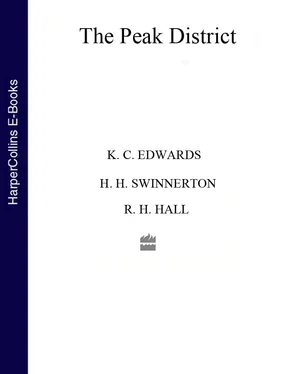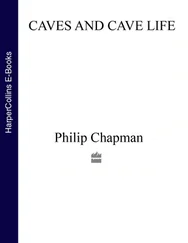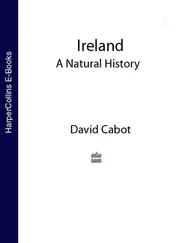At last this arid period known as the Triassic drew to a close. Its plains began to subside, were carried down below sea-level so that these too became submerged. This event ushered in the second division of the Mesozoic Era, known as the Jurassic Period. At first this new sea tended to be muddy but later its waters were often clear during long stretches of time and then limy deposits were laid down. The latter contained numerous small round pellets resembling the roe of fishes. For this reason the rocks formed from these deposits are known as Oolitic Limestones (oos=egg).
The animals that came along with these marine waters were many of them similar to but not identical with those that lived in the Carboniferous sea. There were some near relatives of the Pearly Nautilus but they were few in number and all closely coiled. Descendants of the goniatites abounded but their shells were more prettily ornamented and the partitions between their chambers were complexly folded and even frilled. They are therefore distinguished under the name Ammonites. When the waters were clean and clear, stone lilies and corals became common but differed from their Carboniferous allies in many details. Sea-urchins, sea-snails and bivalves also contributed their quota to the building up of the Jurassic deposits and rocks.
Shoals of fishes swarmed in the open waters. Their bodies were clothed in an armour-like mosaic of thick bony scales covered with shiny enamel. They were preyed upon by a new type of animal unknown in Carboniferous waters. These were large reptiles shaped like fishes and almost as perfectly adapted for a life spent wholly in the sea. Conspicuous among these was Ichthyosaurus , a fearsome creature with a large mouth as well-equipped with sharp teeth as that of the crocodile today.
During Jurassic times the floor of the sea was subject to occasional undulatory movements. The crests of some of these undulations rose above sea-level and formed long stretches of land on which grew strange-looking trees allied to the Monkey Puzzle ( Araucaria ) and to tree ferns. As yet there were no herbs with coloured flowers, no grasses, no grassy swards. The landscape must have been a drab expanse, varied here and there only by the dark green foliage of the trees. The scene was, however, enlivened by the presence of many kinds of reptiles of all sizes, crawling, running on all fours or leaping like the kangaroo. Some small forms fed on insects. The larger ones fed on foliage or preyed upon their fellows. There were also some with such large bulky bodies that only by wading up to their necks in water could they support their great weight. Other lightly-built reptiles had large flimsy wings like those of the bats. These pursued and fed upon dragonflies and other flying insects which were at home in the air. As yet there were no birds. From all this it is evident that this period was one in which reptiles dominated air, land and sea. There were a few furred animals or mammals, but they were no larger than rats and mice and survived largely because they led a furtive existence in the crevices of rocks or hiding in the foliage of the trees.
The Jurassic Period was brought to a close by a slow, nearly uniform, lowering of the earth’s crust in the British area. The sea flowed in and eventually submerged the whole with the exception of the highlands of Scotland and Wales. The waters of this sea were clear and warm and teemed with myriads of minute organisms that made tiny shells no larger than a pin’s head. These lived their lives floating in the sunlit waters near the surface. When they died their shells drizzled down to the floor and helped to form deep deposits of white mud which ultimately solidified into the white chalk which makes up the cliffs of Kent and the Downs. The period during which this chalk was formed is known as the Cretaceous (creta=chalk). It was the last of the great divisions of the Mesozoic Era. The thickness of the chalk deposits grew to be 1,000 feet or more and the laying down of the last of those deposits marked the ending of that period and era. The long process of burying the Peak District now ceased.
RE-EMERGENCE
The Mesozoic Era lasted about 120 million years, during which the Peak District lay hidden under an ever-increasing cover of limestones, sandstones, clays and chalk. The time of its eclipse was now, however, drawing to a close, for the British area, after its prolonged period of sinking, began to rise once more. The floor of the chalk sea was uplifted and converted into dry land, an event which marked the opening of the Cainozoic Era.
This uprising did not take place uniformly over the whole area but was most marked along a line running northwards through the area of the Peak District and the Pennines and resulted in the appearance of a low elongated dome. This formed an island which had the scenic features of chalk downs. The crest of this dome served as a natural water divide and many streams flowed down its gentle slopes. The sea floor continued to rise and the boundaries of the land were extended outwards in all directions. The streams lengthened out across the broadening plains as these rose out of the water. Uniting with one another they merged into larger rivers flowing to the sea which by this time was far away.
Wherever streams and rivers flowed they excavated channels which as they deepened were widened into valleys. All this involved the gradual removal of large quantities of rock. The chalk was the first to be attacked. After that the more deeply seated layers of the Jurassic and Triassic rocks were penetrated, a piece of work which was begun and carried farthest upon the original dome. There at last the Carboniferous rocks began to peep out along the beds of the streams. The latter continued to carry away the waste formed by the gradual destruction of the younger rocks on either side of the valleys. But still the streams went on cutting their channels more and more deeply into the Carboniferous rocks. These channels were also widened into valleys and these old rocks came to occupy a correspondingly larger portion of the valley sides. The Mesozoic rocks were steadily reduced to mere remnants capping the hills on either side. Eventually even these disappeared completely and left the Carboniferous rocks in sole possession of the Peak District.
The long eclipse had ended. The precise date for that event is unknown for the complete removal of all the waste from the destruction of so much rock left no tangible evidence behind. It is, however, probable that it happened shortly before or at the opening of the Pliocene period, which was the last of the four major periods into which the last or Cainozoic Era has been divided.
The removal of the Mesozoic rocks was not the only great event that happened during this long period of time. The living garment that clothed the landscape also changed. True flowering plants that produced seeds in closed caskets had come into being in other parts of the world during Cretaceous times. These invaded the new lands as they rose into being over the British area. Among them were many kinds of woodland trees and numerous flowering herbs and grasses which covered the ground as with a multi-coloured carpet. Over this beetles crawled, butterflies flitted and bees hummed. Winged reptiles had passed into oblivion and their place was taken by birds. The long reign of reptiles was over and only a few insignificant representatives remained. On the other hand, mammals were rising rapidly to a position of dominance. A wonderful variety of insect-eaters, vegetable and flesh feeders haunted the woodlands and sported on the grassy plains. Many of these began to show recognisable resemblances to modern and familiar types, to horses, deer, wolves, cats and monkeys. Usually they showed some features that would seem to us to be peculiar.
The Peak District now entered upon the last phase of its long and eventful history. The carving of the scenery as seen now had begun. Even during the time of its eclipse the blue-print for the general arrangement of its hills, valleys and moorlands was being drawn. When in early Cainozoic times the streams and rivers first began to score the surface of the chalky slopes, their direction of the flow was the same as that in which the Mesozoic rocks were dipping. Just as a saw when it has begun cutting through a log of wood must keep to the same line in which it started, so likewise a stream, having once made a track, must keep to it. Having made its bed it must lie on it.
Читать дальше












